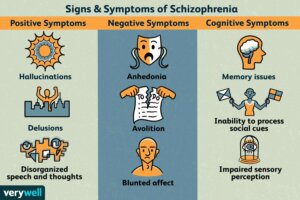Are people diagnosed with schizophrenia dangerous?
The simple answer is no, but then the question is why it is stigmatized? Mental illness has been stigmatized for thousands of years because it was not studied or understood. People were suffering with untreatable symptoms and the public did not know how to react. Thankfully, medicine has come a long way in treating mental illness and people are being diagnosed and treated more effectively. However, the stigmatization remains and individuals continue to view a stereotypical version of people with mental illness. Stigmatization of this at-risk population affects them physically because they have trouble finding care, housing, and employment. To destigmatize this disorder, we need to understand what it is and what it means.
What is Schizophrenia?
The National Alliance on Mental Illness (NAMI) defines it by stating “Schizophrenia is a serious mental illness that interferes with a person’s ability to think clearly, manage emotions, make decisions and relate to others.”
Below is a video posted on the NAMI website that helps to explain schizophrenia:
What are the symptoms?
Although there are different types and severities of schizophrenia, they all share the same group of symptoms as shown in the image below.

Jonny Benjamin was diagnosed with schizoaffective disorder and has been posting about it on YouTube for years. He created the video below to show what living with schizoaffective disorder is like:
How is schizophrenia treated?
The symptoms are treated effectively with uninterrupted access to antipsychotic medications, psychiatrist, therapist, and case manager. Ensuring people with schizophrenia have easy access to these resources is essential for their success. They can only have the access if there is awareness and understanding about the challenges they face.
Therefore, the illness itself is not dangerous but the continued stigmatization of this mental illness is.
Resources
1, Schizophrenia. NAMI. (n.d.). https://www.nami.org/About-Mental-Illness/Mental-Health-Conditions/Schizophrenia
2. Jormfeldt, H., & Hallén, M. (2016). Experiences of housing support in everyday life for persons with schizophrenia and the role of the media from a societal perspective. International Journal of Qualitative Studies on Health and Well-Being, 11, 30571. https://doi-org.ezproxy.neit.edu/10.3402/qhw.v11.30571
3. Athanasopoulou, C., Suni, S., Hätönen, H., Apostolakis, I., Lionis, C., & Välimäki, M. (2016). Attitudes towards schizophrenia on YouTube: A content analysis of Finnish and Greek videos. Informatics for Health & Social Care, 41(3), 307–324. https://doi-org.ezproxy.neit.edu/10.3109/17538157.2015.1008485
4. Zimbres, T. M., Bell, R. A., & Taylor, L. D. (2020). Effects of public versus media responsibility messages on stigmatization of people with schizophrenia in an American adult sample. Social Psychiatry and Psychiatric Epidemiology, 55(7), 917–927. https://doi-org.ezproxy.neit.edu/10.1007/s00127-019-01788-6
5. Bowman, J. W. P., & West, K. (2019). Prime and prejudice: Brief stereotypical media representations can increase prejudicial attitudes and behaviour towards people with schizophrenia. Journal of Community & Applied Social Psychology, 29(3), 167–177. https://doi-org.ezproxy.neit.edu/10.1002/casp.2392
